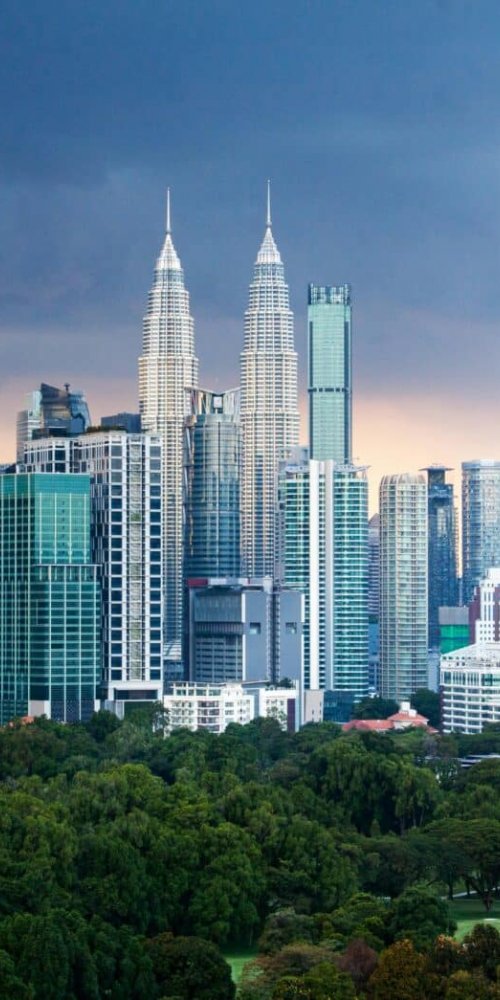
The moment you step into Kuala Lumpur, MY, the city greets you with a rich tapestry of sensory delights. The air is filled with the tantalising aroma of satay grills, blending seamlessly with the sweet scent of tropical blossoms. Tram bells jingle as they thread through busy lanes, mingling with the chatter of street vendors and laughter from bustling markets. As the sun dips, its golden rays bounce off glistening skyscrapers and the delicate tiles of historic rooftops, creating a magical glow that whispers of stories both ancient and modern. It’s a city alive with contrasts, ready to embrace every traveller with its vibrant pulse and warm hospitality.
Quick Facts About Kuala Lumpur, MY
- Population & Languages: Around 1.8 million; official language Malay, English widely spoken.
- Currency & Payments: Malaysian Ringgit (MYR); contactless and e-wallet payments accepted broadly (Tourism Board, March 2025).
- Best Seasons to Visit: May to July and December to February for pleasant weather and less humidity.
- Airport & Transport: Kuala Lumpur International Airport (KLIA) is 50 km from downtown; about 45 minutes by Express Rail Link.
- Transit Pass: Cheapest full-day transit pass is MYR 12 (RideLink Card, 2025).
- Local Coffee Cost: Cappuccino averages MYR 10 in March 2025 at city cafés.
Why Visit Kuala Lumpur, MY?
Kuala Lumpur, MY pulses with an energy like no other Southeast Asian city. A melting pot of Malay, Chinese, and Indian cultures, the city invites you to explore a living mosaic of languages, cuisines, and traditions. When I first climbed the stunning Petronas Towers, the city laid out beneath me like a vibrant canvas, its juxtaposition of sleek towers and colonial walkways instantly captivating. The recent years have seen Kuala Lumpur reinvent itself as a cosmopolitan hub, blending futuristic shopping complexes and art galleries with age-old mosques and bazaars.
The signature vibe is both laid-back and dynamic; whether it's the chatter at a street-side cari-ayam stall or the hum of nightlife in Changkat Bukit Bintang, there’s a genuine warmth to the city’s pulse. In addition, the city stands out for its commitment to green spaces amidst its urban sprawl - with parks and gardens that provide tranquil relief, perfect for contemplative respite or lively picnics.
Whether you're here for the best attractions Kuala Lumpur, MY offers or the thrill of uncovering hidden gems Kuala Lumpur, MY is famed for, you’ll never be short of places to explore or flavours to savor. The city’s seamless blend of heritage and modernity ensures that every corner you turn tells a new story.
Top 10 Must-Do Experiences in Kuala Lumpur, MY
- Ascend the Petronas Twin Towers: Experience panoramic city views from the iconic sky bridge and observation deck. A true symbol of Kuala Lumpur, MY’s modern spirit and architectural marvel.
- Explore Batu Caves: Marvel at the giant golden statue and intricate cave temples. This cultural landmark offers insights into Hindu traditions and colourful festivities throughout the year.
- Walk Through Bukit Bintang: Shop, dine, and people-watch in the city’s premier entertainment district, featuring vibrant street art and lively night markets.
- Visit the Islamic Arts Museum Malaysia: Feast your eyes on exquisite calligraphy, textiles, and artefacts representing Islamic heritage in Asia and beyond.
- Stroll in KL Forest Eco Park: A lush, green oasis in the city centre - the canopy walkway lets you spot exotic birds amid ancient rainforest trees.
- Discover Chinatown (Petaling Street): Bargain for souvenirs and savour street food gems like char kuey teow and roasted chestnuts in a market bursting with energy.
- Experience the Kuala Lumpur Tower (Menara KL): Head up the observation deck or try the thrilling Sky Box for views over the city skyline and distant hills.
- Relax at Perdana Botanical Gardens: Amid themed gardens and serene lakes, it’s the perfect spot to unwind and embrace the local pace of life.
- Explore the National Museum: Deepen your understanding of Malaysia’s diverse history, culture, and natural environment through engaging exhibits.
- Sample Jalan Alor Night Food Market: Let your taste buds roam through a riot of street-food stalls serving spicy satay, tangy asam laksa, and refreshing tropical juices.
Price & Time Grid for Top Attractions
| Attraction | Adult Ticket (MYR) | Avg Visit Time | Skip-the-Line? | Nearest Metro/Bus Stop |
|---|---|---|---|---|
| Petronas Twin Towers | 80 | 2-3 hrs | Available | KLCC Station (LRT) |
| Batu Caves | Free entry | 2 hrs | No | Batu Caves Station (Komuter) |
| Bukit Bintang | Free | Varies | N/A | Bukit Bintang Station (MRT) |
| Islamic Arts Museum Malaysia | 14 | 1.5 hrs | No | Pasar Seni Station (LRT) |
| KL Forest Eco Park | Free | 1-2 hrs | No | Pasar Seni Station (LRT) |
| Chinatown (Petaling Street) | Free | 1-2 hrs | N/A | Pasar Seni Station (LRT) |
| Kuala Lumpur Tower | 49 | 1-1.5 hrs | Available | Bukit Nanas Station (Monorail) |
| Perdana Botanical Gardens | Free | 1.5-2 hrs | No | Muzium Negara Station (Komuter) |
| National Museum | 5 | 1 hr | No | Muzium Negara Station (Komuter) |
| Jalan Alor Night Food Market | Free entry | Varies | N/A | Bukit Bintang Station (MRT) |
Comparing prices and visit durations, you’ll find that many top activities in Kuala Lumpur, MY are wallet-friendly or free, allowing you to experience a range of culture and nature without overspending. Skip-the-line options are perfect for peak visiting hours, particularly for the Petronas Towers and KL Tower, saving time for exploring vibrant neighbourhoods.
Neighbourhood Snapshots
KLCC & Bukit Bintang
KLCC dazzles with its iconic skyscrapers and upscale shopping malls, while nearby Bukit Bintang beats with the heart of Kuala Lumpur’s nightlife and street-food scenes. By day, luxury brands and cafes rule, and by night, street stalls fill the air with enticing aromas. The area offers a cosmopolitan vibe perfect for those seeking both glamour and local charm.
Chinatown (Petaling Street)
This bustling district is a sensory overload in the best way - vibrant markets, colourful temples, and food stalls crowd narrow streets beneath hanging lanterns. It’s the soul of the city's heritage, where you can haggle over souvenirs and sample traditional snacks such as Hokkien mee or kaya toast in lively kopitiams.
Bangsar
More laid-back yet trendy, Bangsar thrives as a cosmopolitan hub for eclectic dining and indie boutiques. Contemporary cafes and bars spill onto streets buzzing with creative energy, favoured by expats and locals alike who appreciate a blend of western and local flavours paired with art exhibitions and live music.
Kampung Baru
A green, traditional Malay village neighbour in the city’s core, Kampung Baru preserves old wooden houses and open-air markets. It’s a peaceful contrast to the surrounding skyscrapers, where you can experience authentic Malay food like nasi lemak in simple, humble eateries that locals cherish.
Kuala Lumpur - Recommended Companies
Hidden Gems & Local Culture
- Kampar Artist Courtyard: A tucked-away cluster of studios showcasing contemporary Malaysian art, hosting monthly open studios and workshops.
- The Hive atop Bukit Bintang: A secret rooftop bar hidden within a hotel, offering craft cocktails with incredible skyline views and a chilled vibe far from typical tourist spots.
- Readings Vintage Book Arcade: Located near Central Market, this arcade specialises in rare Malay and English literature, a haven for book lovers and culture seekers.
Getting Around the City

Metro: Kuala Lumpur’s extensive metro network (LRT, MRT, Monorail) is the fastest and most reliable way to navigate between main sights. The stations are clean, air-conditioned, and connect well to most tourist hotspots.
Bike-Share: For short distances, bike-share services like oBike and Lime are gaining popularity, especially around park areas and city-centre lanes. The dedicated bike lanes are improving, making it a fun way to explore neighbourhood spots at your own pace.
Pedestrian Zones: Central areas like Bukit Bintang and Chinatown are very walkable, with wide pavements and pedestrian bridges linking malls and attractions. Evening walks here are lively and safe, ideal for soaking up the night market atmosphere.
Taxi & Rideshare: E-hailing apps like Grab dominate the city scene, offering convenient rides at reasonable prices. Taxis exist but are less popular among visitors due to metering issues, so app-based options are recommended.
Money-Saving Tips
- Buy a prepaid transit card (RideLink or Touch ‘n Go) for discounted fares and easy metro/bus access across the city.
- Eat like a local at hawker centres and street food markets where meals cost a fraction of what you’d pay in tourist restaurants.
- Visit free attractions like KL Forest Eco Park and Perdana Botanical Gardens to enjoy nature without spending.
- Plan your visit on weekdays to avoid weekend price surges and crowds, especially at landmarks and markets.
- Use e-wallet promotions and discounts prevalent in Kuala Lumpur, MY’s retail and transport sectors (checked March 2025).
Sample 3-Day Kuala Lumpur, MY Itinerary
- Day 1: Morning trip to Petronas Towers & KLCC Park, afternoon stroll through Bukit Bintang and Pavilion Shopping Mall, evening dinner at Jalan Alor Night Food Market.
- Day 2: Explore Batu Caves early, visit the Islamic Arts Museum, afternoon walk in Chinatown & Central Market, sunset at Kuala Lumpur Tower.
- Day 3: Relax in Perdana Botanical Gardens, visit National Museum, afternoon coffee and shopping in Bangsar, night drinks at The Hive rooftop bar.
Common Mistakes Visitors Make
- Underestimating how much time to spend at Petronas Towers; arriving late limits viewing options - go early.
- Not carrying cash (MYR) for hawker street food - digital payments aren’t always accepted at small stalls.
- Skipping Chinatown because it seems touristy - you’ll miss authentic tastes and vibrant culture.
- Ignoring weather forecasts - Kuala Lumpur can have sudden heavy rain; pack a lightweight raincoat.
- Relying solely on taxis without apps leads to overpaying - use Grab for fair pricing.
- Visiting Batu Caves midday in hot sun - go early morning to avoid heat and crowds.
- Assuming English is universally spoken - while common, learning basic Malay greetings eases interactions.
- Not exploring neighbourhoods beyond the city centre misses rich local dining and cultural experiences.
Frequently Asked Questions
What is the best time of year to visit Kuala Lumpur, MY?
The best months are May to July and December to February when rainfall is lower and temperatures are milder, making outdoor sightseeing comfortable.
Are the top attractions in Kuala Lumpur, MY family-friendly?
Absolutely. Places like KLCC Park, Aquaria KLCC, and Batu Caves cater well to families with interactive exhibits and shaded walkways.
What local foods should I try while exploring the city?
Don't miss nasi lemak, satay, roti canai, and char kuey teow - each offers a distinct flavour insight into Malaysia’s culinary diversity.
Is it safe to walk around at night in Kuala Lumpur?
Popular neighbourhoods like Bukit Bintang and Chinatown are generally safe and bustling after dark, but exercise usual urban caution with belongings.
Ready for Your Kuala Lumpur, MY Adventure?
There’s no shortage of things to do in Kuala Lumpur, MY - from breathtaking landmarks to secret local hideouts. Whether your heart beats for cultural discoveries or vibrant street life, the city has a tailor-made experience waiting for you. I’d love to hear your own Kuala Lumpur stories or help with advice - drop a comment below and sign up for our newsletter to never miss insider tips. Safe travels!






